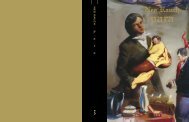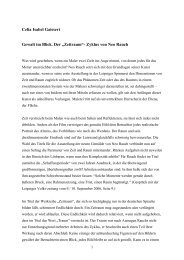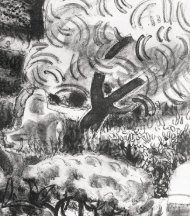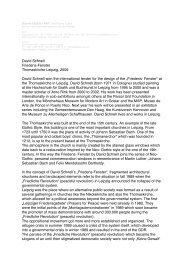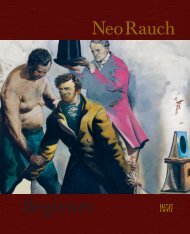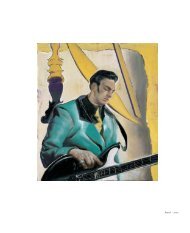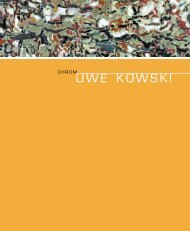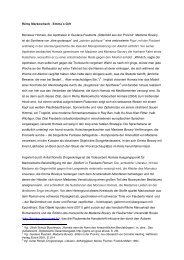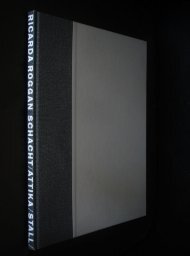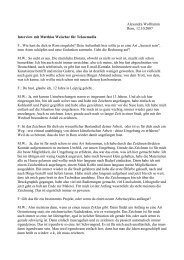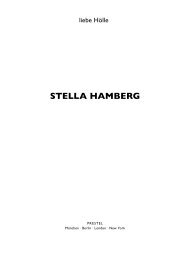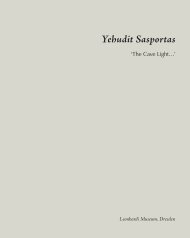Nina Fischer & Maroan el Sani Blind Spots
Nina Fischer & Maroan el Sani Blind Spots
Nina Fischer & Maroan el Sani Blind Spots
Erfolgreiche ePaper selbst erstellen
Machen Sie aus Ihren PDF Publikationen ein blätterbares Flipbook mit unserer einzigartigen Google optimierten e-Paper Software.
Hou Hanru<br />
Catching the Zeitgeist<br />
xoo – ex ovo omnia<br />
<strong>Nina</strong> <strong>Fischer</strong> and <strong>Maroan</strong> <strong>el</strong> <strong>Sani</strong>’s work<br />
is a permanent pursuit of and negotiation<br />
with the transition of time, or the transition<br />
of epochs, that has marked the very<br />
zeitgeist of our post-Cold War and global<br />
capitalist age. They explore the historic<br />
traces of urban landmarks, monuments<br />
and events that embody such a transition.<br />
Their work critically demonstrates the rise<br />
and fall of modernity, the intense and<br />
uncanny r<strong>el</strong>ationship between our contemporary<br />
society and utopian projects that<br />
have driven the evolution of our history,<br />
from the past to the future, or the anachronistic<br />
merging of both ends.<br />
Having experienced first hand the fall<br />
of the Berlin Wall and the reunification of<br />
Germany, the artists have been systematically<br />
focusing their attention and imagination<br />
on the contradictory effects of such<br />
a transition. The transformed urban and<br />
architectural spaces in East Berlin that<br />
most visibly incarnate this crucial event<br />
have become the very sites of their investigation<br />
and creation. Locations that particularly<br />
attract their attention are those<br />
which stand to highlight the socialist<br />
construction of the German Democratic<br />
Republic such as the Palace of the<br />
Republic, the East Berlin Radio Station<br />
and the meeting places of the subculture<br />
such as underground clubs, often abandoned<br />
and facing gentrification projects<br />
today. However, instead of focusing<br />
on the overwh<strong>el</strong>ming monumentality and<br />
sublime aesthetic forms of these dramatic<br />
edifices, <strong>Fischer</strong> and <strong>el</strong> <strong>Sani</strong> prefer to<br />
penetrate into the internal worlds of the<br />
spaces, which are rapidly being reduced,<br />
emptied and even demolished under the<br />
pressure of privatisation. There remains<br />
a spirit that haunts these sites, whether<br />
they are destroyed or complet<strong>el</strong>y transformed.<br />
This very spirit, the Geist, the mysterious<br />
carrier of past events and memory,<br />
is exactly what the artists look to capture<br />
and make visible through their work.<br />
Modernist buildings that once promised<br />
a utopian future provide new territories<br />
for many artists, architects and theoreticians.<br />
<strong>Fischer</strong> and <strong>el</strong> <strong>Sani</strong> continue in their<br />
efforts to investigate and question the<br />
nature of ‘utopia’, and the inevitable futility<br />
of these ghost-like monuments. Their<br />
research is not limited to the borders of<br />
former East Berlin. In some of their recent<br />
works they have shifted their attention<br />
to a considerably different but equally in-<br />
tensive site of geopolitical transition: Paris.<br />
And this shift opens up a new space in<br />
which they can further explore the fate<br />
of ‘utopia’ as a universal concern. This is<br />
particularly meaningful in our time as we<br />
struggle to probe the myths of globalisation.<br />
Spending months in the French capital,<br />
they invested their energy and imagination<br />
in exploring two important sites that have<br />
undergone an equally important transformation:<br />
the old Bibliothèque Nationale<br />
and the headquarters of the French<br />
Communist Party (PCF). The latter build-<br />
ing experienced a similar fate to that<br />
of the Palace of the Republic in Berlin.<br />
It is a UFO-like modernist masterpiece,<br />
a beautiful and audacious symbol of communist<br />
idealism. It was designed by Oscar<br />
Niemeyer while living in exile in Paris<br />
soon after he had fled the Brazilian dictatorship.<br />
The PCF commission was started<br />
in 1965 but the building was not finished<br />
until 1980, by which time the party had<br />
dramatically decreased in popularity. Now<br />
the building is occasionally rented out<br />
to transnational corporations to stage<br />
events such as fashion shows. <strong>Fischer</strong><br />
and <strong>el</strong> <strong>Sani</strong> exploited this highly symbolic<br />
site, once again, to set up a scenario<br />
of a haunting ghost movie, which reveals<br />
the legacy of its ‘utopia’, its rise and fall.<br />
Clearly, the site represents a kind of hardwon<br />
utopia in the heart of this western<br />
capital which is facing the same gentrification<br />
as anywhere. And this gentrification<br />
is one of the clearest signs of the globalisa-<br />
tion of the freemarket economy, nam<strong>el</strong>y<br />
late capitalism, which is in its<strong>el</strong>f a curious<br />
mixture of utopianism and cynicism. As<br />
John Ralston Saul points out, globalisation,<br />
or its philosophy (globalism), purporting<br />
to be economically inevitable, is in<br />
fact another form of ideology, a disguised<br />
one that is ruling the world in a violent but<br />
efficient way when other ideologies are<br />
abandoned. 1<br />
xoo – ex ovo omnia is an ambitious<br />
series of video and photographic works<br />
dev<strong>el</strong>oped to understand the complex<br />
structure of the PCF. If the destiny of the<br />
PCF and its headquarters, in trying to<br />
survive the wave of late capitalism and<br />
social cynicism of today, is to embody<br />
both physically and spiritually a common<br />
struggle for many in our time to maintain<br />
a sense of the meaning of life, then the<br />
artists’ intervention becomes even more<br />
significant. They introduced a new perspective<br />
to their work – they staged a<br />
science-fiction performance. ‘The white<br />
concrete dome is the site of an unusual<br />
experiment: two actors in white protection<br />
suits are concentrating on lining up raw<br />
eggs on the white conference tables. The<br />
task requires a calm hand, great patience<br />
and an understanding of complex structures<br />
such as the architecture of an egg<br />
… We were drawn to the building’s futuristic<br />
shape which allows us to look into<br />
the future from the standpoint of the past.’<br />
This bizarre, swift, phantom-like appearance<br />
of the two performers, who are<br />
dressed complet<strong>el</strong>y in white and against<br />
a white background, provokes a fe<strong>el</strong>ing<br />
of suspicion. And we ask: Where are we?<br />
Why are we here? Is it the real world? Or<br />
are we on an unknown planet? Perhaps<br />
it is in this moment of uncertain inquiry<br />
that the power of this utopian building,<br />
indeed of any utopian project, can be<br />
expressed. By its nature, utopia is unrealisable.<br />
But, like a Geist that continually<br />
returns, it always haunts our lives. Is<br />
it a ghost of Malevich’s White On White,<br />
a truly revolutionary painting? Or can our<br />
time still be r<strong>el</strong>ated to it at all? In either<br />
case, <strong>Nina</strong> <strong>Fischer</strong> and <strong>Maroan</strong> <strong>el</strong> <strong>Sani</strong><br />
are the catchers of our zeitgeist.<br />
Note<br />
1. John Ralston Saul, The Collapse of<br />
Globalism and the Reinvention of the World,<br />
Atlantic, London 2005.<br />
Hou Hanru<br />
Den Zeitgeist einfangen<br />
xoo – ex ovo omnia<br />
<strong>Nina</strong> <strong>Fischer</strong> und <strong>Maroan</strong> <strong>el</strong> <strong>Sani</strong>s Werk<br />
ist eine fortwährende Beschäftigung und<br />
Auseinandersetzung mit den Übergängen<br />
zwischen Zeiten und Epochen, die<br />
den Zeitgeist unserer vom globalen Kapitalismus<br />
geprägten Ära nach dem Kalten<br />
Krieg kennzeichnen. Sie wand<strong>el</strong>n auf den<br />
historischen Spuren urbaner Orientierungspunkte,<br />
Denkmäler und Ereignisse,<br />
die einen derartigen Übergang verkörpern,<br />
und verdeutlichen so den Aufstieg<br />
und Fall der Moderne oder die enge und<br />
doch unheimliche Beziehung zwischen<br />
unserer gegenwärtigen Ges<strong>el</strong>lschaft und<br />
utopischen Projekten, die den Lauf der<br />
Geschichte aus der Vergangenheit heraus<br />
bis in die Zukunft hinein vorangetrieben<br />
haben, oder die anachronistische Verschm<strong>el</strong>zung<br />
beider Enden.<br />
Die Künstler haben den Fall der Berliner<br />
Mauer und die Wiedervereinigung<br />
Deutschlands unmitt<strong>el</strong>bar miterlebt und<br />
richten ihre Aufmerksamkeit und Vorst<strong>el</strong>lungskraft<br />
systematisch auf die Frage<br />
nach den Widersprüchlichkeiten, die mit<br />
einer derartigen historischen Umwälzung<br />
einhergehen. Die Veränderung urbaner<br />
und architektonischer Räume im Ostteil<br />
der Stadt st<strong>el</strong>lt die sichtbarste und deutlichste<br />
Folge dieses Schlüss<strong>el</strong>ereignisses<br />
dar, und genau hier waren die beiden<br />
investigativ und schöpferisch tätig. Besonders<br />
jene Orte, die die Höhepunkte<br />
sozialistischer Baukunst in der DDR darst<strong>el</strong>lten<br />
– wie der Palast der Republik oder<br />
das Gebäude des DDR-Rundfunkzentrums<br />
in Ost-Berlin –, und die Treffpunkte<br />
der Subkultur, wie beispi<strong>el</strong>sweise die<br />
Underground-Klubs erregen ihre Aufmerksamkeit;<br />
Orte, die heute oft verlassen<br />
und in Gefahr sind, Gentrifizierungsprojekten<br />
weichen zu müssen.<br />
Statt sich allerdings von der Monumentalität,<br />
den erhabenen ästhetischen<br />
Formen und dem dramatischen Schicksal<br />
der Gebäude überwältigen zu lassen,<br />
dringen die beiden Künstler lieber in das<br />
Innenleben der Räume vor, die unter dem<br />
Druck der Privatisierung urbaner Räume<br />
in rasender Geschwindigkeit dezimiert,<br />
entkernt und sogar abgerissen werden.<br />
Diese Stätten werden jedoch immer von<br />
einer Art Geist heimgesucht, auch wenn<br />
sie zerstört oder vollkommen transformiert<br />
werden. Es ist eben dieser geheimnis-<br />
volle Geist der Vergangenheit, der Erin-<br />
nerung, der Geschichte, den <strong>Fischer</strong> und<br />
<strong>el</strong> <strong>Sani</strong> in ihrer künstlerischen Arbeit<br />
einfangen und sichtbar machen wollen.<br />
Die modernistischen Gebäude, die<br />
einst eine Utopie versprachen, bieten vi<strong>el</strong>en<br />
Künstlern, Architekten und Theoretikern<br />
ein neues Terrain – unter ihnen auch<br />
<strong>Fischer</strong> und <strong>el</strong> <strong>Sani</strong>, die mit ihren Bemühungen<br />
fortfahren, das Wesen der Utopie<br />
und deren gespenstisch-absurde Unvermeidbarkeit<br />
zu erforschen und infrage zu<br />
st<strong>el</strong>len. Ihre künstlerische Forschungsarbeit<br />
bleibt nicht auf das einstige Ost-Berlin<br />
beschränkt. In einigen ihrer jüngsten<br />
Werke haben sie die Aufmerksamkeit auf<br />
einen ganz anderen, aber gleichermaßen<br />
beziehungsreichen Ort des geopolitischen<br />
Übergangs verlagert: auf Paris. Und diese<br />
Verlagerung eröffnet ihnen einen neuen<br />
Raum, in dem sie das Schicksal der Utopie<br />
als univers<strong>el</strong>les Thema weiter erforschen<br />
können. In unserer Zeit, in der wir<br />
alle Anstrengungen unternehmen, die<br />
Mythen der Globalisierung zu durchdringen,<br />
ist dies besonders bedeutsam.<br />
Während mehrerer Monate, die sie in<br />
dieser westeuropäischen Hauptstadt ver-<br />
brachten, verwendeten die beiden Künstler<br />
ihre Energie und Vorst<strong>el</strong>lungskraft<br />
darauf, zwei wichtige Stätten zu erforschen,<br />
die einer ebenso bedeutsamen<br />
Verwandlung unterworfen waren: die alte<br />
Bibliothèque Nationale und die Zentrale<br />
der Kommunistischen Partei Frankreichs<br />
(PCF). Letztere teilt in gewisser Hinsicht<br />
mit dem Berliner Palast der Republik ein<br />
gemeinsames Schicksal. Sie ist ein modernistisches<br />
Meisterwerk, das wie ein<br />
UFO aussieht, ein schönes und kühnes<br />
Symbol des kommunistischen Idealismus.<br />
Der Entwurf stammt von Oscar Niemeyer<br />
und entstand kurz nach dessen Flucht<br />
vor der brasilianischen Diktatur ins Exil<br />
nach Paris. Der Auftragsbau der PCF wur-<br />
de zwar bereits 1965 begonnen, jedoch<br />
erst 1980 fertiggest<strong>el</strong>lt, als die Partei<br />
bereits einen gravierenden Popularitätsschwund<br />
zu verzeichnen hatte. Jetzt wird<br />
das Gebäude g<strong>el</strong>egentlich für Veranstaltungen<br />
wie Modenschauen an multinationale,<br />
kapitalistische Unternehmen<br />
vermietet. Einmal mehr nutzten <strong>Fischer</strong><br />
und <strong>el</strong> <strong>Sani</strong> diese höchst symbolische<br />
Stätte als Kulisse für einen ,Gespensterfilm‘,<br />
der das Schicksal der Utopie, ihren<br />
Aufstieg und Fall offenbart. Im Herzen von<br />
Paris repräsentiert dieser Ort deutlich<br />
gerade die Art von hart erkämpfter Utopie,<br />
die gegenwärtig allenthalben der Gentrifizierung<br />
ausgesetzt ist. Und diese Gentrifizierung<br />
ist eines der offensichtlichsten<br />
Symptome der globalisierten freien Marktwirtschaft,<br />
des Spätkapitalismus, der<br />
s<strong>el</strong>bst eine eigenartige Mischung aus<br />
Utopismus und Zynismus ist. Wie John<br />
Ralston Saul anmerkt, ist Globalisierung<br />
oder die ihr zugrunde liegende Philosophie<br />
(der Globalismus), die behauptet,<br />
es hand<strong>el</strong>e sich hierbei um eine zwangsläufige<br />
wirtschaftliche Entwicklung, in<br />
Wirklichkeit auch nur eine Form verhüllter<br />
Ideologie, die die W<strong>el</strong>t aggressiv, aber<br />
auf effiziente Weise beherrscht, wo andere<br />
Ideologien ausgedient haben. 1<br />
xoo – ex ovo omnia besteht aus einem<br />
Videofilm und einer Reihe von Fotografien,<br />
die dabei h<strong>el</strong>fen sollen, die komplexe<br />
Struktur der PCF zu verstehen. Wenn es<br />
das Schicksal der Partei und ihrer Zentrale<br />
ist, mit ihrem Überlebenskampf in der heu-<br />
tigen vom Spätkapitalismus und sozialen<br />
Zynismus geprägten Zeit sowohl physisch<br />
als auch moralisch dem Kampf Vi<strong>el</strong>er<br />
Ausdruck zu verleihen, die Sinn für ihr<br />
Leben reklamieren, verleiht dies der künstlerischen<br />
Intervention zusätzliche Bedeutsamkeit.<br />
Die beiden Künstler führten eine<br />
neue Perspektive in ihr Werk ein: Sie<br />
inszenierten eine futuristische Performance.<br />
„Die weiße Betonkupp<strong>el</strong> ist Schauplatz<br />
eines ungewöhnlichen Experiments: Zwei<br />
Schauspi<strong>el</strong>er in weißen Schutzanzügen<br />
verwenden ihre ganze Konzentration darauf,<br />
auf den ebenfalls weißen Konferenztischen<br />
rohe Eier in Reihen anzuordnen.<br />
Die Aufgabe erfordert eine ruhige Hand,<br />
große Geduld und ein Verständnis komplexer<br />
Strukturen, wie das Ei eine ist …<br />
Wir waren von der futuristischen Form<br />
des Gebäudes fasziniert, die uns gestattet,<br />
aus der Vergangenheit heraus in die<br />
Zukunft zu blicken.“<br />
Dieser bizarre, flüchtige, absurde,<br />
phantomartige Auftritt der Darst<strong>el</strong>ler, ganz<br />
in Weiß und vor einem weißen Hintergrund<br />
agierend, weckt ein bemerkenswertes<br />
Gefühl des Misstrauens. Es lässt uns<br />
fragen: Wo sind wir? Warum sind wir hier?<br />
Ist dies die reale W<strong>el</strong>t? Oder befinden<br />
wir uns auf einem fremden Planeten?<br />
Vi<strong>el</strong>leicht kann in einem derart unsicheren<br />
Moment des Hinterfragens die Kraft dieser<br />
utopischen Architektur und damit jedes<br />
utopischen Projekts am besten zum Ausdruck<br />
gebracht werden. Die Utopie ist<br />
ihrem Wesen nach nicht realisierbar. Aber<br />
wie ein Geist, der ewig wiederkehrt, ver-<br />
folgt sie uns für immer. Ist sie ein Geist<br />
aus Malewitschs wahrhaft revolutionärem<br />
Gemälde Weiß auf Weiß? Hat unsere Zeit<br />
überhaupt noch etwas damit zu tun? Wie<br />
dem auch sei, <strong>Nina</strong> <strong>Fischer</strong> und <strong>Maroan</strong><br />
<strong>el</strong> <strong>Sani</strong> fangen unseren Zeitgeist ein.<br />
Notiz<br />
1. John Ralston Saul, The Collapse of Globalism<br />
and the Reinvention of the World, Atlantic,<br />
London 2005.



